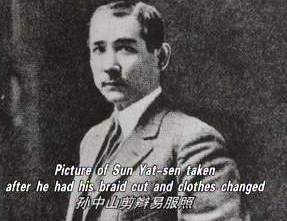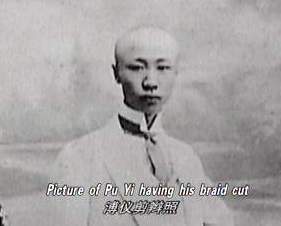 |
|
Dream of the Republic (2)
A Movement of Having Braids Cut |
| CCTV.COM 2002-08-23 12:08:59 |
|
Many Chinese joined the revolution to overthrow the imperial court by having their braids cut as a first step. They had worn long braids for nearly 300 years. Wearing long braids, Manchu armymen entered the Great Wall in 1644. Men of the Han nationality were ordered to keep long braids too, for wearing long braids were a symbol of being loyal to the Qing emperor. A government notice was first hung on the stem of a barber's load. Now there hung a towel and a piece of cloth for sharpening the knife. Under the threat of keeping their head or hair, all the Han nationality men had to keep long braids, so shaving became a new trade. Barbers went from street to street and attracted their customers by making a sound with an instrument.
 Over 200 years later, braids once again became a focus in the political struggle in China. It was a first step taken by revolutionaries to have their braids cut to show their determination in breaking with the Qing court. In 1895, Sun Yat-sen threw himself into the republican revolution by having his braid cut and clothes changed in Japan. And in 1903, Lu Xun also had his braid cut while studying in Japan. He wrote a poem on the backside of the photo, showing his concern about his country and people. Over 200 years later, braids once again became a focus in the political struggle in China. It was a first step taken by revolutionaries to have their braids cut to show their determination in breaking with the Qing court. In 1895, Sun Yat-sen threw himself into the republican revolution by having his braid cut and clothes changed in Japan. And in 1903, Lu Xun also had his braid cut while studying in Japan. He wrote a poem on the backside of the photo, showing his concern about his country and people.
During its reform policy and owing to the pressure from both the ruling party and the opposition, the Qing government became flexible in carrying out the law of wearing braids. Hall for Aid in Governance passed the case of having braids cut and clothes changed in 1910. In the same year, Zhang Yuan held a meeting to have braids cut. The long braids came to an end with the downfall of the Qing court.
In 1912, the new national government issued a public notice No.29, calling on people to have their braids cut. A revolutionary reform began with the change in people's daily life.
Yin Mingde of 97 years old recalls: "I was old enough to remember how Sun Yat-sen led the revolution. Parades took place in the street. People carried with them brooms to show that they would wipe out old habits with them. Girls would no longer bind their feet while men would wear no braids, because braids had no use. But they still felt uneasy when they had their braids cut. Quite many men didn’t want to have their braids cut."
It was hard for Chinese men to lose their braids at first, so wearing hats began to be popular. Sheng Xi Fu Hats Shop of a high reputation was set up in 1912. The shop was busy in making hats day and night but the supply still fell short of demand. It was one of the quick changes that took place in social habits.
 It was a brand new era with a scene of vitality. People changed their hairstyle, clothing and mental outlook. It was a brand new era with a scene of vitality. People changed their hairstyle, clothing and mental outlook.
But in the Forbidden City, old fogies and young diehards were still living in the bygone days. Ten years later, Pu Yi, their Master and the abdicated Emperor, cut his braid with his own hand when he was 16 years old.
|
|
|
|
|
|
|
 |









